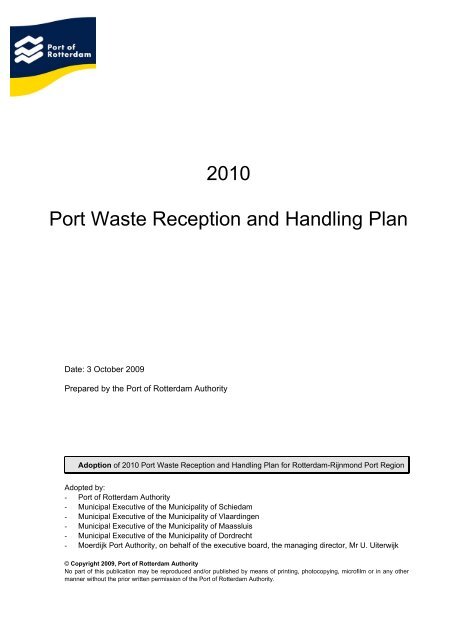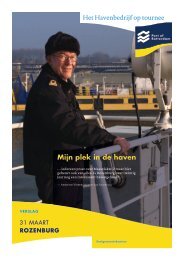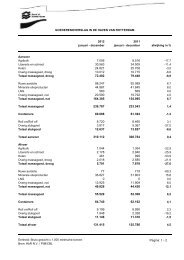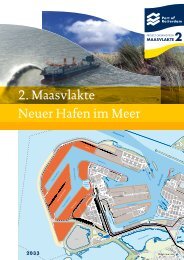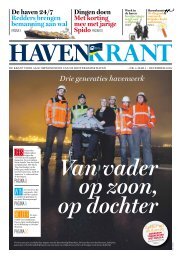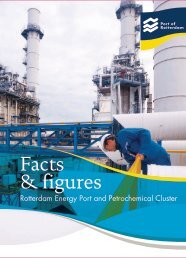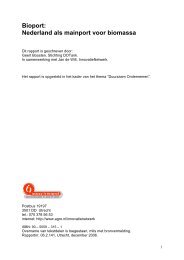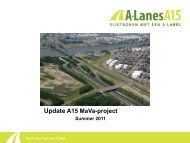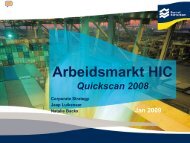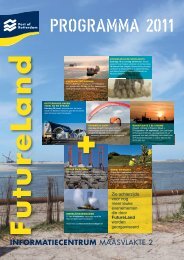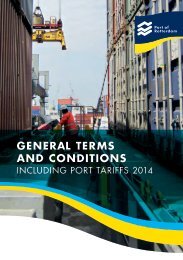2010 Port Waste Reception and Handling Plan - Port of Rotterdam
2010 Port Waste Reception and Handling Plan - Port of Rotterdam
2010 Port Waste Reception and Handling Plan - Port of Rotterdam
Create successful ePaper yourself
Turn your PDF publications into a flip-book with our unique Google optimized e-Paper software.
<strong>2010</strong><strong>Port</strong> <strong>Waste</strong> <strong>Reception</strong> <strong>and</strong> H<strong>and</strong>ling <strong>Plan</strong>Date: 3 October 2009Prepared by the <strong>Port</strong> <strong>of</strong> <strong>Rotterdam</strong> AuthorityAdoption <strong>of</strong> <strong>2010</strong> <strong>Port</strong> <strong>Waste</strong> <strong>Reception</strong> <strong>and</strong> H<strong>and</strong>ling <strong>Plan</strong> for <strong>Rotterdam</strong>-Rijnmond <strong>Port</strong> RegionAdopted by:- <strong>Port</strong> <strong>of</strong> <strong>Rotterdam</strong> Authority- Municipal Executive <strong>of</strong> the Municipality <strong>of</strong> Schiedam- Municipal Executive <strong>of</strong> the Municipality <strong>of</strong> Vlaardingen- Municipal Executive <strong>of</strong> the Municipality <strong>of</strong> Maassluis- Municipal Executive <strong>of</strong> the Municipality <strong>of</strong> Dordrecht- Moerdijk <strong>Port</strong> Authority, on behalf <strong>of</strong> the executive board, the managing director, Mr U. Uiterwijk© Copyright 2009, <strong>Port</strong> <strong>of</strong> <strong>Rotterdam</strong> AuthorityNo part <strong>of</strong> this publication may be reproduced <strong>and</strong>/or published by means <strong>of</strong> printing, photocopying, micr<strong>of</strong>ilm or in any othermanner without the prior written permission <strong>of</strong> the <strong>Port</strong> <strong>of</strong> <strong>Rotterdam</strong> Authority.
CONTENTSINTRODUCTION ......................................................................................................................3SECTION 1: TERMINOLOGY ..................................................................................................4SECTION 2: STATUTORY FRAMEWORK AND AREA OF APPLICATION ............................6SECTION 3: FEES & REIMBURSEMENTS ............................................................................8SECTION 4: PORT RECEPTION FACILITIES.......................................................................12SECTION 5: VISITING SEAGOING VESSELS......................................................................15SECTION 6: SUPERVISION AND ENFORCEMENT.............................................................22SECTION 7: REPORTING .....................................................................................................23SECTION 8: ORGANISATION AND COMMUNICATION ......................................................24Appendix 1: List <strong>of</strong> designated <strong>Port</strong> <strong>Reception</strong> Facilities........................................................25Appendix 2: Notification form..................................................................................................28Appendix 3: Adoption decisions by port managers in the <strong>Rotterdam</strong>-Rijnmond <strong>Port</strong> Region.29Appendix 4: quantities <strong>of</strong> ship waste, harmful substances <strong>and</strong> residues <strong>of</strong> harmfulsubstances received <strong>and</strong> processed between 2006 <strong>and</strong> 2008. .........................................35Version 3 October 2009 page 2 <strong>of</strong> 36 <strong>2010</strong> <strong>Port</strong> <strong>Waste</strong> <strong>Reception</strong> <strong>and</strong> H<strong>and</strong>ling <strong>Plan</strong>
INTRODUCTIONAs European Mainport <strong>Rotterdam</strong> is visited by more than 35,000 seagoing vessels each year. Shipson continental <strong>and</strong> intercontinental voyages produce ship waste en route. In addition, cargo residuesare left behind after the unloading <strong>of</strong> specific product flows. In order to prevent pollution <strong>of</strong> the sea <strong>and</strong>coastal waters the seaports in the Rijnmond Area facilitate <strong>Port</strong> <strong>Reception</strong> Facilities (PRF) where shipwaste can be delivered. It is after all <strong>of</strong> great importance that ship waste <strong>and</strong> cargo residues can bedelivered at a port <strong>of</strong> call efficiently <strong>and</strong> in an environmentally responsible manner.On 29 December 2002 the European Directive no. 2000/59/EC on port reception facilities for shipwaste <strong>and</strong> cargo residues (OJ L 332) came into effect. The purpose <strong>of</strong> this directive is the furtherreduction <strong>of</strong> discharges <strong>of</strong> ship waste <strong>and</strong> cargo residues into the sea. This directive thereforeconstitutes a further tightening <strong>of</strong> the MARPOL Convention.The provisions <strong>of</strong> the aforementioned directive were implemented in the Netherl<strong>and</strong>s by amendment<strong>of</strong> the Wet voorkoming verontreiniging door schepen (Wvvs – Prevention <strong>of</strong> Pollution from Ships Act).Pursuant to the provisions <strong>of</strong> Article 6, paragraph 1 <strong>of</strong> the Wvvs the manager <strong>of</strong> a seaport designatedby governmental decree must ensure an adequate facility suitable for the reception <strong>of</strong> ship waste.The port <strong>of</strong> <strong>Rotterdam</strong> is such a designated seaport 1 . The <strong>Port</strong> <strong>of</strong> <strong>Rotterdam</strong> Authority was appointedmanager <strong>of</strong> the <strong>Rotterdam</strong> port 2 . Pursuant to the provisions <strong>of</strong> Article 6, paragraph 3 <strong>of</strong> the Wvvs theport manager must draw up a suitable plan for the reception <strong>and</strong> processing <strong>of</strong> ship waste.On account <strong>of</strong> the foregoing the <strong>Port</strong> <strong>of</strong> <strong>Rotterdam</strong> Authority must therefore prepare the <strong>Port</strong> <strong>Waste</strong><strong>Reception</strong> <strong>and</strong> H<strong>and</strong>ling <strong>Plan</strong> (PWP)for the port <strong>of</strong> <strong>Rotterdam</strong>. The <strong>Port</strong> <strong>of</strong> <strong>Rotterdam</strong> Authority agreedin conjunction with the managers <strong>of</strong> the ports <strong>of</strong> Dordrecht, Maassluis, Moerdijk, Schiedam <strong>and</strong>Vlaardingen to adopt one joint PWP within the meaning <strong>of</strong> Article 6, paragraph 4 <strong>of</strong> the Wvvs for thewhole <strong>of</strong> the <strong>Rotterdam</strong>-Rijnmond <strong>Port</strong> Region. The <strong>Port</strong> <strong>of</strong> <strong>Rotterdam</strong> Authority was requested to takethe initiative in this. This <strong>2010</strong> PWP is the result <strong>of</strong> this <strong>and</strong> therefore applies to the entire <strong>Rotterdam</strong>-Rijnmond <strong>Port</strong> Region. The PWP was drafted following consultations with the relevant parties,including users, shipping agents, shipping companies, recipients, processors, permit issuers <strong>and</strong>enforcers in the <strong>Rotterdam</strong>-Rijnmond <strong>Port</strong> Region.Pursuant to the provisions <strong>of</strong> Article 6a <strong>of</strong> the Wvvs port managers must levy a fee towards the costs<strong>of</strong> reception, storage <strong>and</strong> processing <strong>of</strong> ship waste on operators <strong>of</strong> ships which call in at their ports.This is also referred to as indirect financing. Section 3 <strong>of</strong> this PWP sets forth the levels <strong>of</strong> the fees <strong>and</strong>reimbursements for the entire <strong>Rotterdam</strong>-Rijnmond <strong>Port</strong> Region. The guiding principle in this was theachievement <strong>of</strong> a balance between the costs <strong>and</strong> benefits <strong>of</strong> a cleaner environment.With this PWP, the previous PWP will cease to apply. The <strong>2010</strong> <strong>Port</strong> <strong>Waste</strong> <strong>Reception</strong> <strong>and</strong> H<strong>and</strong>ling<strong>Plan</strong> will come into effect on 1 October 2009.1 Cf. Article 2 <strong>of</strong> the <strong>Port</strong> <strong>Reception</strong> Facilities Decree in conjunction with Article 10 <strong>of</strong> the <strong>Port</strong> <strong>Reception</strong> Facilities Regulations2TK (Lower House), 2003-2004, 29 400, no. 3, p. 28.Version 3 October 2009 page 3 <strong>of</strong> 36 <strong>2010</strong> <strong>Port</strong> <strong>Waste</strong> <strong>Reception</strong> <strong>and</strong> H<strong>and</strong>ling <strong>Plan</strong>
SECTION 1: TERMINOLOGYThis section explains the terminology used in the <strong>Port</strong> <strong>Waste</strong> <strong>Reception</strong> <strong>and</strong> H<strong>and</strong>ling <strong>Plan</strong> (PWP).Ballast waterWater which is taken on board in order to control the trim, list, draught, stability <strong>of</strong> or forces imposedon the ship.FeeFee as referred to in Article 6a, paragraph 1 <strong>of</strong> the Wvvs.Direct financingFinancing other than indirect financing.OperatorThe natural person or legal entity who has control over the use <strong>of</strong> a ship.<strong>Port</strong>The harbours, sites, waters, quays, jetties, dolphins, buoys <strong>and</strong> other similar structures or fittingsadministered by the various port managers in the entire <strong>Rotterdam</strong>-Rijnmond <strong>Port</strong> Region.<strong>Port</strong> <strong>Waste</strong> <strong>Reception</strong> <strong>and</strong> H<strong>and</strong>ling <strong>Plan</strong><strong>Plan</strong> as referred to in Article 6, paragraph 3 <strong>of</strong> the Wvvs.<strong>Port</strong> Manager• port <strong>of</strong> <strong>Rotterdam</strong>: <strong>Port</strong> <strong>of</strong> <strong>Rotterdam</strong> Authority• port <strong>of</strong> Schiedam: the Municipality <strong>of</strong> Schiedam• port <strong>of</strong> Vlaardingen: the Municipality <strong>of</strong> Vlaardingen• port <strong>of</strong> Maassluis: the Municipality <strong>of</strong> Maassluis• port <strong>of</strong> Dordrecht: The Dordrecht <strong>Port</strong> Authority• port <strong>of</strong> Moerdijk: The Moerdijk <strong>Port</strong> Authority<strong>Port</strong> <strong>Reception</strong> Facility (PRF)Fixed facility (including tanks, platforms, depositories <strong>and</strong> other storage spaces which form part <strong>of</strong> anestablishment) or mobile facility (collection vehicle or collection vessel) suitable for the reception <strong>of</strong>ship waste; also referred to as recipient.Indirect financingFinancing as referred to in Article 6a, paragraph 1 <strong>of</strong> the Wvvs in conjunction with Article 7 <strong>of</strong> the <strong>Port</strong><strong>Reception</strong> Facilities Regulations.CollectorOwner <strong>of</strong> <strong>Port</strong> <strong>Reception</strong> Facility who has all the required public-law exemptions including at least - ifapplicable – a legally valid designation pursuant to the municipal <strong>Port</strong> Management Bye-Lawsapplicable to the relevant part <strong>of</strong> the <strong>Rotterdam</strong>-Rijnmond <strong>Port</strong> Region, <strong>and</strong> an environmental permit.CaptainThe master or skipper <strong>of</strong> a ship or the person who replaces him.Ship waste<strong>Waste</strong> including residues other than cargo residues <strong>and</strong> sewage which is generated during theoperation <strong>of</strong> a ship <strong>and</strong> which falls under the scope <strong>of</strong> Annexes I, IV, <strong>and</strong> V <strong>of</strong> the Convention for thePrevention <strong>of</strong> Pollution from Ships (Marpol Convention), as well as cargo-associated waste, being allthe material that is left on board as waste after the stowage <strong>and</strong> h<strong>and</strong>ling <strong>of</strong> the cargo, includingdunnage, shoring, pallets, packaging material, wooden sheets, paper, cardboard, wire or steel b<strong>and</strong>s.Version 3 October 2009 page 4 <strong>of</strong> 36 <strong>2010</strong> <strong>Port</strong> <strong>Waste</strong> <strong>Reception</strong> <strong>and</strong> H<strong>and</strong>ling <strong>Plan</strong>
Cargo residuesThe remnants <strong>of</strong> any cargo material on board in cargo holds or tanks which remain after unloading<strong>and</strong> cleaning operations, including loading/unloading excesses <strong>and</strong> spillage.MARPOL 73/78 (see also 2.1.1.):The International Convention for the Prevention <strong>of</strong> Pollution from Ships adopted on 2 November 1973in London, with Protocols <strong>and</strong> Annexes with Appendices as amended <strong>and</strong> supplemented by theProtocol relating to that Convention with Annex <strong>and</strong> Appendices adopted on 17 February 1978 inLondon.DisposerA person who wishes to dispose <strong>of</strong> ship waste, harmful substances or cargo residues by deliveringthem to a collector, waste treater or waste processor.Recreational craftA ship <strong>of</strong> any type, regardless <strong>of</strong> the means <strong>of</strong> propulsion, intended or used for sports or leisurepurposes.Shipping agentA person who acts in a pr<strong>of</strong>essional capacity as representative <strong>of</strong> the natural person or legal entitywho uses the port with a ship <strong>and</strong> who has a Dutch postal address <strong>and</strong> is registered with the Chamber<strong>of</strong> Commerce.ShipAny vessel <strong>of</strong> whatever type used at sea including hydr<strong>of</strong>oil boats, air-cushion vehicles, submersiblevessels <strong>and</strong> floating equipment as well as installations whilst they are afloat except for when the shipas referred to above has been positioned above the seabed for the exploration <strong>of</strong> the presence <strong>of</strong>minerals or for the mining there<strong>of</strong>.ProcessorA natural person or legal entity who operates an installation to whom disposers or collectors can <strong>of</strong>fership waste, harmful substances <strong>and</strong> cargo residues for processing.Fishing vesselA ship equipped or used commercially for catching fish or other living resources <strong>of</strong> the sea.Version 3 October 2009 page 5 <strong>of</strong> 36 <strong>2010</strong> <strong>Port</strong> <strong>Waste</strong> <strong>Reception</strong> <strong>and</strong> H<strong>and</strong>ling <strong>Plan</strong>
SECTION 2: STATUTORY FRAMEWORK AND AREA OF APPLICATIONIn this section, in addition to a summary <strong>of</strong> applicable legislation <strong>and</strong> formalities for deliverythe geographical area <strong>of</strong> application to which the <strong>Port</strong> <strong>Waste</strong> <strong>Reception</strong> <strong>and</strong> H<strong>and</strong>ling <strong>Plan</strong>applies is given.2.1 Statutory framework2.1.1 International regulations: MARPOL 73/78The purpose <strong>of</strong> MARPOL 73/78 is the reduction <strong>of</strong> marine pollution which is the result <strong>of</strong> discharges <strong>of</strong>harmful substances from ships. Rules <strong>and</strong> regulations are attached to discharges at sea. Furthermorespecific requirements are set for the construction, fitting out <strong>and</strong> equipping <strong>of</strong> ships.In its capacity as contracting state the Netherl<strong>and</strong>s implements the conditions <strong>and</strong> provisions <strong>of</strong> MARPOL73/78 <strong>and</strong> the ratified Annexes (I, II, III, IV, V <strong>and</strong> VI) for its territory <strong>and</strong> territorial waters. MARPOL 73/78has been implemented via the Wet voorkoming verontreiniging door schepen (Wvvs – Prevention <strong>of</strong>Pollution from Ships Act) whereby the structure <strong>of</strong> MARPOL 73/78 is followed as much as possible.2.1.2 European regulationsThe following European regulations play a role:• Council Regulation (EEC) No. 2913/92 <strong>of</strong> 12 October 1992 establishing the CommunityCustoms Code (delivered ship waste is regarded as non-Community goods which arereleased for free circulation as referred to in Article 79 <strong>of</strong> this Regulation);• Council Directive 91/156 amending Directive 75/442/EEC on waste;• Council Directive 75/439/EEC on the disposal <strong>of</strong> waste oils;• Council Directive 91/689 on harmful waste;• Council Directive 95/21 concerning the enforcement, in respect <strong>of</strong> shipping usingCommunity ports <strong>and</strong> sailing in the waters under the jurisdiction <strong>of</strong> the Member States,<strong>of</strong> international st<strong>and</strong>ards for ship safety, pollution prevention <strong>and</strong> shipboard living <strong>and</strong>working conditions (port State control)2.1.3 National regulations: Wvvs <strong>and</strong> Wet Milieubeheer (Environmental Management Act)The above described international <strong>and</strong> European frameworks have been implemented in theNetherl<strong>and</strong>s via the Wvvs. Pursuant to the Wvvs further rules are set in this respect in the followinggovernmental decrees <strong>and</strong> ministerial regulations:• Besluit havenontvangstvoorzieningen (Bhov - <strong>Port</strong> <strong>Reception</strong> Facilities Decree)• Regeling havenontvangstvoorzieningen (Rhov - <strong>Port</strong> <strong>Reception</strong> Facilities Regulations)• Besluit voorkoming verontreiniging door schepen (Bvvs - Prevention <strong>of</strong> Pollution from ShipsDecree)• Regeling voorkoming verontreiniging door schepen (Rvvs - Prevention <strong>of</strong> Pollution from ShipsRegulations)• Regeling inzake het scheiden en gescheiden houden van gevaarlijke afvalst<strong>of</strong>fen (Regulationsconcerning the segregation <strong>of</strong> harmful waste)Rules are also set regarding the collection <strong>and</strong> processing <strong>of</strong> waste in the Environmental ManagementAct <strong>and</strong> the governmental decrees <strong>and</strong> regulations pursuant thereto. It concerns:• Besluit inzamelen afvalst<strong>of</strong>fen (Collection <strong>of</strong> <strong>Waste</strong> Decree)• Regeling inzamelaars, vervoerders, h<strong>and</strong>elaars en bemiddelaars van afvalst<strong>of</strong>fen (Collectors,Carriers, Traders <strong>and</strong> Brokers <strong>of</strong> <strong>Waste</strong> Regulations)• Regeling melden bedrijfsafvalst<strong>of</strong>fen en gevaarlijke st<strong>of</strong>fen (Regulations for Reporting <strong>of</strong>commercial waste <strong>and</strong> harmful waste)Version 3 October 2009 page 6 <strong>of</strong> 36 <strong>2010</strong> <strong>Port</strong> <strong>Waste</strong> <strong>Reception</strong> <strong>and</strong> H<strong>and</strong>ling <strong>Plan</strong>
• L<strong>and</strong>elijk afvalbeheerplan 2002-2012 (2002-2012 National <strong>Waste</strong> Management <strong>Plan</strong>)In addition the following regulations are important:• Scheepvaartreglement territoriale zee (Territorial Seas Shipping Regulations);• Wet op de economische delicten (Economic Offences Act).2.1.4 <strong>Port</strong> Bye-LawsThe <strong>Port</strong> (Management) Bye-Laws <strong>of</strong> all <strong>Port</strong> Managers contain rules with regard to the designation <strong>of</strong>owners <strong>of</strong> <strong>Port</strong> <strong>Reception</strong> Facilities.It is prohibited for the owner <strong>of</strong> a <strong>Port</strong> <strong>Reception</strong> Facility who does not possess a designation to takereceipt <strong>of</strong> ship waste, harmful substances or residues from seagoing vessels.An owner who does possess a designation is, by reason <strong>of</strong> the stipulations included in thedesignation, obliged to collect ship waste, harmful substances or residues from seagoing vessels<strong>of</strong>fered to him <strong>and</strong> <strong>of</strong>fer them for further processing.2.2 Area <strong>of</strong> application<strong>Rotterdam</strong>-Rijnmond <strong>Port</strong> RegionThis <strong>Port</strong> <strong>Waste</strong> <strong>Reception</strong> <strong>and</strong> H<strong>and</strong>ling <strong>Plan</strong> – as is evident from the introduction – has been jointlyprepared, made available for inspection <strong>and</strong> adopted by the port managers <strong>of</strong> the ports in <strong>Rotterdam</strong>,Schiedam <strong>and</strong> Vlaardingen, Dordrecht, Moerdijk <strong>and</strong> Maassluis. These ports are collectively referred toas the <strong>Rotterdam</strong>-Rijnmond <strong>Port</strong> Region. The PWP’s area <strong>of</strong> application is the ports located in the<strong>Rotterdam</strong>-Rijnmond <strong>Port</strong> Region.Version 3 October 2009 page 7 <strong>of</strong> 36 <strong>2010</strong> <strong>Port</strong> <strong>Waste</strong> <strong>Reception</strong> <strong>and</strong> H<strong>and</strong>ling <strong>Plan</strong>
SECTION 3: FEES & REIMBURSEMENTS3.1 IntroductionIn this section the bases <strong>and</strong> levels <strong>of</strong> the fees <strong>and</strong> reimbursements for ship waste are addressed.3.2 System <strong>of</strong> indirect financing3.2.1 Indirect financingDirective 2000/59/EC introduces compulsory indirect financing. The system essentially entails that allseagoing vessels which call on a Dutch seaport contribute towards the costs <strong>of</strong> the port receptionfacilities irrespective <strong>of</strong> whether ship waste is in fact delivered.Payment <strong>of</strong> the indirect fee subsequently gives the captain the non-transferable right to deliver acertain quantity <strong>of</strong> ship waste during the stay <strong>of</strong> the ship in the port concerned without being obliged topay a separate fee. The port manager may determine the maximum quantity per waste flow, theproperties <strong>and</strong> the manner <strong>of</strong> delivery <strong>of</strong> the ship waste concerned.If the captain wishes to deliver more ship waste than is covered by the indirect financing system, thesurplus falls under the direct financing system. This means that the ship will have to pay the costsdirectly to the collector. This <strong>of</strong> course also applies to the categories <strong>of</strong> ship waste <strong>and</strong> cargo residueswhich are not included in the system <strong>of</strong> indirect financing.Summary <strong>of</strong> what is covered by direct <strong>and</strong> indirect financing:convention waste type type <strong>of</strong> waste feefuel residuesused engine oilbilge watership-relatedMARPOL 73/78,ANNEX IMARPOL 73/78,ANNEX IIMARPOL 73/78,ANNEX IVMARPOL 73/78,ANNEX VMARPOL 73/78,ANNEX VIBALLAST WATERCONVENTIONoily tank washingsballast water (from cargotanks)tank washings chemicalscargo-associatedwastecargo-associatedwaste (see § 5.3.2)(partly)indirectdirectdirectsewage ship-related directdomestic wastesmall dangerous wasteplasticfood wastecargo-associated wasteother wastedry cargo residuesship-relatedcargo-associatedwaste(partly)indirectdirectdirectdirectozone-depleting substances ship-related direct(un)treated ballast waterresidue cleaning technologysediment ballast tankship-relateddirectThe money which the port manager receives as a result <strong>of</strong> the aforementioned fee per ship is used topay the collectors <strong>of</strong>/ owners <strong>of</strong> <strong>Port</strong> <strong>Reception</strong> Facilities for ship waste in settlement <strong>of</strong> a part <strong>of</strong> thecosts involved in the collection, storage, transport <strong>and</strong> processing <strong>of</strong> ship waste.Version 3 October 2009 page 8 <strong>of</strong> 36 <strong>2010</strong> <strong>Port</strong> <strong>Waste</strong> <strong>Reception</strong> <strong>and</strong> H<strong>and</strong>ling <strong>Plan</strong>
3.2.2 Fee obligationIn general the fee obligation applies to all seagoing vessels which call in at one <strong>of</strong> the seaports forwhich the PWP was adopted unless the ship has been exempted therefrom pursuant to the provisions<strong>of</strong> Article 35a <strong>of</strong> the Wvvs (see § 5.4), or has been exempted pursuant to local regulations (port duesbye-laws or general terms <strong>and</strong> conditions, see § 3.4).The fee obligation also applies to seagoing vessels which leave the port <strong>and</strong> return 4 hours laterunless it concerns a tide-bound ship which visits the Cal<strong>and</strong>kanaal from the Nieuwe Waterweg or viceversa via the <strong>of</strong>fshore separation buoy.Seagoing vessels which do not moor in one <strong>of</strong> the ports <strong>of</strong> the <strong>Rotterdam</strong>-Rijnmond <strong>Port</strong> Region donot have to pay any fee.3.2.3 Payment <strong>of</strong> feeThe <strong>Port</strong> <strong>of</strong> <strong>Rotterdam</strong> Authority collects the indirect fee at the same time as the seaport dues for allport managers <strong>of</strong> the <strong>Rotterdam</strong>-Rijnmond <strong>Port</strong> Region. The indirect fee is shown separately on thereceipt. In settlement <strong>of</strong> administrative costs the <strong>Port</strong> <strong>of</strong> <strong>Rotterdam</strong> Authority withholds € 15 per payingship.Any direct costs which are incurred when the disposer <strong>of</strong>fers more waste than is covered by theindirect financing system, must be paid by the disposer directly to the owner <strong>of</strong> the <strong>Port</strong> <strong>Reception</strong>Facility.3.2.4 VerificationThe <strong>Port</strong> <strong>of</strong> <strong>Rotterdam</strong> Authority will, after an administrative check on the basis <strong>of</strong> the ‘S’ forms, thesubstance registration forms <strong>and</strong> the statements submitted by the <strong>Port</strong> <strong>Reception</strong> Facility, pay theamounts due to the owner <strong>of</strong> a <strong>Port</strong> <strong>Reception</strong> Facility (designated pursuant to the port (management)bye-laws concerned) into the bank account <strong>of</strong> the owner concerned as a provisional payment.The verification <strong>of</strong> environmental hygiene with regard to collection, transport, intermediate storage <strong>and</strong>processing is carried out by other government departments such as the province <strong>of</strong> South Holl<strong>and</strong>, theDCMR Environmental Protection Agency Rijnmond, the Ministry <strong>of</strong> Housing, Spatial <strong>Plan</strong>ning <strong>and</strong> theEnvironment (VROM), the National Police Services Agency (KLPD), the <strong>Rotterdam</strong>-Rijnmond SeaportPolice (ZHP) <strong>and</strong> the Directorate-General for Public Works <strong>and</strong> Water Management (RWS).After the <strong>Port</strong> <strong>of</strong> <strong>Rotterdam</strong> Authority has received the annual audit report from the owner <strong>of</strong> the <strong>Port</strong><strong>Reception</strong> Facility (see § 4.3.1) <strong>and</strong> approved this, the earlier provisional payments become final.3.3 Bases <strong>of</strong> the indirect financing system usedThe indirect fee system consists <strong>of</strong> two components: the fee for oily ship-related waste <strong>and</strong> the fee forsolid ship-related waste.The level <strong>of</strong> the fee has been made dependent upon the capacity <strong>of</strong> the main engine (kilowatt= 1.36hp; hereinafter: kW) <strong>of</strong> the ship concerned.If the capacity <strong>of</strong> the main engine is unknown, the ship will be classified as category G or corrected bythe <strong>Rotterdam</strong> Division Harbour Master (DHMR).The level <strong>of</strong> the waste fee is included in the general terms <strong>and</strong> conditions/ port dues bye-laws <strong>of</strong> therelevant port manager. The level <strong>of</strong> the waste fee may be adjusted every year.Version 3 October 2009 page 9 <strong>of</strong> 36 <strong>2010</strong> <strong>Port</strong> <strong>Waste</strong> <strong>Reception</strong> <strong>and</strong> H<strong>and</strong>ling <strong>Plan</strong>
The classification <strong>of</strong> the categories is as follows:categoryABCDEFGmain engine capacity1 – 1,999 kW2,000 – 3,999 kW4,000 – 7,499 kW7,500 – 9,999 kW10,000 – 14,999 kW15,000 – 29,999 kW≥ 30,000 kWFees are not transferable or exchangeable <strong>and</strong> apply per visit. Owners <strong>of</strong> <strong>Port</strong> <strong>Reception</strong> Facilitiesonly receive a fee if the ships h<strong>and</strong>led by them have paid a fee.The tariffs include an administrative surcharge for the <strong>Port</strong> <strong>of</strong> <strong>Rotterdam</strong> Authority <strong>of</strong> € 15 towards theadministrative costs involved in the receipt, checking, processing <strong>and</strong> forwarding <strong>of</strong> the notificationforms <strong>and</strong> the payment <strong>of</strong> the fees.The waste fee is shown on the invoice which is sent at the same time as the invoice for the seaportdues. In the specification the fees for Annexes I <strong>and</strong> V are both shown.3.3.1 Fee & reimbursement for Annex I: oily waste from the engine room 3The table below shows the fee <strong>and</strong> reimbursement as at 1-10-2009.category Fee (€)Reimbursementannex I 4ship-related (€)A 25 300B 50 500C 100 700D 200 900E 300 1,100F 400 1,300G 550 1,500FeeFor the collection, transport, (intermediate storage) <strong>and</strong> processing <strong>of</strong> ship waste to which the system<strong>of</strong> indirect financing applies, the owners <strong>of</strong> <strong>Port</strong> <strong>Reception</strong> Facilities receive a fee per ship h<strong>and</strong>led bythem as shown above. The provisional fee will be paid monthly following submission <strong>of</strong> a summary <strong>of</strong>the collections together with copies <strong>of</strong> the invoices to the shipping agencies <strong>and</strong> an invoice.Ships 5 which use marine diesel oil, marine gas oil or LNG (MDO/MGO/LNG) as fuel may apply forexemption from the Annex I fee. They must report this to the Harbour Master by e-mail (Transport <strong>and</strong>Environmental Safety Department; TMV_staf@port<strong>of</strong>rotterdam.com) prior to arrival in the port. Thefact that these ships do not pay any fee for oily waste also means that these ships do not receive anycompensation (via the collector). The exemption is not set <strong>of</strong>f retrospectively.3.3.2 Fee & disposal rights for Annex V: domestic waste, plastic <strong>and</strong> small dangerous wasteThe table below shows the fees <strong>and</strong> reimbursements as at 1-10-2009:3 ludge, afgewerkte olie en bilgewater4Bilge water, Sludge, Used Engine Oil only.5Prior to 1-1-2008 category A ships were automatically given this position. Deliveries showed that many ships <strong>of</strong> this categorydid deliver their Annex I waste.Version 3 October 2009 page 10 <strong>of</strong> 36 <strong>2010</strong> <strong>Port</strong> <strong>Waste</strong> <strong>Reception</strong> <strong>and</strong> H<strong>and</strong>ling <strong>Plan</strong>
Category Fee (€) delivery entitlementAnnex Vship-related (m 3 )ABCDEFGsmall dangerous waste(Annex V) discountship-related (€)195 3 80275 6 150A tariff has been chosen to cover both collection <strong>and</strong> processing costs. The fee for domestic waste isbased on the number <strong>of</strong> crew members on board. The prevailing delivery pattern <strong>and</strong> dimensions <strong>of</strong>collection facilities (waste containers) have resulted in two classes:• ships with < 12 crew members with a maximum <strong>of</strong> 3 m³ <strong>of</strong> waste delivery;• ships with > 12 crew members with a maximum <strong>of</strong> 6 m³ <strong>of</strong> waste delivery.If the waste has been compressed, the waste volume <strong>of</strong>fered is multiplied by a factor <strong>of</strong> 3. This inconnection with the higher processing costs <strong>of</strong> compressed waste.Service levelVia Annex V waste collector Bek & Verburg B.V. the following services are <strong>of</strong>fered:• Reimbursements apply for delivery from Monday to Saturday inclusive from 07:30 to 17:30 hours;• Maximum st<strong>and</strong>-by time <strong>of</strong> 30 minutes for collection vessels <strong>and</strong> Trucks is guaranteed in the case<strong>of</strong> notification 24 hours prior to arrival or at the latest upon departure from the previous port;• Tariffs are based on “one stop <strong>and</strong> go”, i.e. ship or lorry comes alongside, loads waste stream<strong>and</strong> departs.3.4 Ships outside the financing schemeA fee for ship waste is not charged for the use <strong>of</strong> the <strong>Rotterdam</strong>-Rijnmond <strong>Port</strong> Region by:• vessels for which an exemption has been granted pursuant to Article 35a <strong>of</strong> the Wvvs from theprovisions under or pursuant to Articles 6a, 12a or 12b <strong>of</strong> the Wvvs• vessels equipped or used commercially for sports or leisure purposes <strong>and</strong> which may notcarry more than 12 passengers.• fishing vessels• dredgers• sounding vessels• port tugboats, only if <strong>and</strong> ins<strong>of</strong>ar as these are used within the framework <strong>of</strong> normal assistanceto seagoing vessels when entering or leaving <strong>of</strong> the <strong>Port</strong>• a seagoing vessel which visits the port in transit to/from the hinterl<strong>and</strong> or exclusively forbunkering, provided that the ship does not stay in the <strong>Port</strong> for longer than four hours• seagoing vessels which use gas oil or LNG (MDO/MGO/LNG) as propulsion fuel, only ins<strong>of</strong>aras these vessels deliver oily ship wasteIt speaks for itself that the notification <strong>and</strong> delivery obligations apply in full to these categories <strong>of</strong> ship<strong>and</strong> that they fall under the direct financing scheme.Version 3 October 2009 page 11 <strong>of</strong> 36 <strong>2010</strong> <strong>Port</strong> <strong>Waste</strong> <strong>Reception</strong> <strong>and</strong> H<strong>and</strong>ling <strong>Plan</strong>
SECTION 4: PORT RECEPTION FACILITIESIn this section the capacity requirement <strong>and</strong> availability <strong>of</strong> port reception <strong>and</strong> processing facilities in thevarious ports to which the PWP applies are discussed.4.1 Capacity requirementNumber <strong>of</strong> seagoing vessels <strong>and</strong> visitsThe following table shows the number <strong>of</strong> visits between 2000 <strong>and</strong> 2008. The number <strong>of</strong> paying shipsfrom the year that the Wvvs ship waste fee was introduced in the <strong>Rotterdam</strong>-Rijnmond <strong>Port</strong> Region(2005) onwards is also shown in the table.Number <strong>of</strong> sea-going vessels40.00035.00030.00025.00020.00015.000Number sea-going vesselsPaying vessels10.0005.00002000 2001 2002 2003 2004 2005 2006 2007 2008 2009Year 2000 2001 2002 2003 2004 2005 2006 2007 2008 2009Sea-going vessels 30.207 29.557 29.088 33.312 34.831 34.954 35.990 37.095 36.780 33.352Paying vessels 20.222 20.451 22.564 22.157 20.1834.2 Number <strong>of</strong> deliveriesThe following table gives an overview <strong>of</strong> the total number <strong>of</strong> deliveries <strong>and</strong> the quantities <strong>of</strong> allcategories <strong>of</strong> ship waste collected over the period 2004-2008.year 2004 2005 2006 2007 2008Number <strong>of</strong> seagoing vessels visiting the <strong>Rotterdam</strong>-Rijnmond <strong>Port</strong> Region 34,831 34,954 35,990 37,095 36,780number <strong>of</strong> Annex I deliveries (ship waste) 1,351 4,756 2,530 3,368 4,756total quantity <strong>of</strong> ship waste delivered (m 3 ) 34,749 41,756 42,417 54,640 61,567average quantity <strong>of</strong> ship waste delivered (m 3 /deliverer) 26 9 17 16 13number <strong>of</strong> Annex IV deliveries 19 37 46 61 39total quantity <strong>of</strong> Annex IV delivered (m 3 ) 703 4,294 2,878 4,760 2,244average quantity <strong>of</strong> Annex IV delivered (m 3 /deliverer) 37. 116 63 78 58number <strong>of</strong> Annex V deliveries (ship waste) 4,398 15,462 22,026 29,646 34,346total quantity <strong>of</strong> Annex V delivered (m 3 ) 19,923 28,584 21,745 33,873 35,826average quantity <strong>of</strong> Annex V delivered (m 3 /deliverer) 5 2 1 1 1Appendix 4 contains an extensive overview <strong>of</strong> the quantities <strong>of</strong> ship waste, harmful substances <strong>and</strong>residues <strong>of</strong> harmful substances received <strong>and</strong> processed between 2006 <strong>and</strong> 2008.4.3 <strong>Port</strong> <strong>Reception</strong> FacilitiesVersion 3 October 2009 page 12 <strong>of</strong> 36 <strong>2010</strong> <strong>Port</strong> <strong>Waste</strong> <strong>Reception</strong> <strong>and</strong> H<strong>and</strong>ling <strong>Plan</strong>
The following paragraphs state the number <strong>of</strong> companies in the <strong>Rotterdam</strong>-Rijnmond <strong>Port</strong> Regionwhich are involved in the reception <strong>and</strong> processing <strong>of</strong> the various types <strong>of</strong> waste. It is also investigatedwhether in view <strong>of</strong> the available capacity, any bottlenecks can be foreseen.As per 1-1-2009 21 owners have been designated in the <strong>Rotterdam</strong>-Rijnmond <strong>Port</strong> Region as <strong>Port</strong><strong>Reception</strong> Facility for the collection <strong>of</strong> ship waste, harmful substances <strong>and</strong> cargo residues. A list <strong>of</strong> thedesignated owners is included as Appendix 1 to this PWP. 15 <strong>of</strong> these <strong>Port</strong> <strong>Reception</strong> Facilities havemobile collection facilities (ships or Trucks) or fixed facilities (storage tanks) for the reception <strong>of</strong> shipwaste. In addition, 6 terminals are owners <strong>of</strong> collection facilities which facilities can only be used byships whose goods have been h<strong>and</strong>led at the terminal.The capacity <strong>of</strong> the <strong>Port</strong> <strong>Reception</strong> Facilities is described per company <strong>and</strong> port manager in Appendix1 to the PWP. Several companies are active in several port management areas in the <strong>Rotterdam</strong>-Rijnmond <strong>Port</strong> Region. The capacity has turned out to be sufficient during the last few years for thedelivery pattern <strong>of</strong> the ships visiting the <strong>Rotterdam</strong>-Rijnmond <strong>Port</strong> Region. In the last few years nocomplaints have been received regarding the capacity <strong>of</strong> the <strong>Port</strong> <strong>Reception</strong> Facilities. At presentthere are sufficient <strong>Port</strong> <strong>Reception</strong> Facilities in the <strong>Rotterdam</strong>-Rijnmond <strong>Port</strong> Region.An up-to-date summary <strong>of</strong> the designated collection companies is kept up to date onwww.port<strong>of</strong>rotterdam.com/en <strong>and</strong> in the IMO’s publicly accessible international database:gisis.imo.org.4.3.1 Rules for the <strong>Port</strong> <strong>Reception</strong> FacilitiesIn all ports within the <strong>Rotterdam</strong>-Rijnmond <strong>Port</strong> Region owners <strong>of</strong> <strong>Port</strong> <strong>Reception</strong> Facilities must havea designation from the Municipal Executive pursuant to the provisions <strong>of</strong> the local port (management)bye-laws. Various conditions <strong>and</strong> stipulations are attached to such a designation.In addition the following requirements apply within the <strong>Rotterdam</strong>-Rijnmond <strong>Port</strong> Region. If these arecomplied with the owner <strong>of</strong> the <strong>Port</strong> <strong>Reception</strong> Facility is eligible for a fee in respect <strong>of</strong> the collection<strong>and</strong> processing costs following submission <strong>of</strong> an electronic monthly report. 6• The electronic monthly report must be submitted by the operator <strong>of</strong> the <strong>Port</strong> <strong>Reception</strong> Facilityto the <strong>Port</strong> <strong>of</strong> <strong>Rotterdam</strong> Authority, Division Harbour Master 7 . This report must include at leastthe following information:• summary <strong>of</strong> indirect fee per delivery as referred to in § 3.3.1 <strong>and</strong> § 3.3.2• name <strong>of</strong> deliverer (+ category <strong>of</strong> seagoing vessel)• name <strong>of</strong> processor(s)• waste flow• date <strong>of</strong> delivery by seagoing vessel to collector• quantity <strong>of</strong> waste collected• The monthly report must be submitted electronically before the 15 th <strong>of</strong> the following month.• In addition owners <strong>of</strong> <strong>Port</strong> <strong>Reception</strong> Facilities must, pursuant to the provisions <strong>of</strong> Article 5 <strong>of</strong>the <strong>Port</strong> <strong>Reception</strong> Facilities Regulations, also submit an electronic quarterly report to the <strong>Port</strong><strong>of</strong> <strong>Rotterdam</strong> Authority, Division Harbour Master This report must contain the followinginformation:• summary <strong>of</strong> direct <strong>and</strong> indirect fees per delivery as referred to in § 3.3.1 <strong>and</strong> 3.3.2• name <strong>of</strong> disposer• waste flow• date <strong>of</strong> delivery by seagoing vessel to collector• quantity <strong>of</strong> waste collected• date <strong>of</strong> transfer to processor(s)• name(s) <strong>of</strong> processor(s)• This report must be submitted electronically within 1 month <strong>of</strong> the end <strong>of</strong> the quarter inaccordance with the Division Harbour Master format.6See Section 3 for the detailed indirect fee system.7Transport <strong>and</strong> Environmental Safety (department)Version 3 October 2009 page 13 <strong>of</strong> 36 <strong>2010</strong> <strong>Port</strong> <strong>Waste</strong> <strong>Reception</strong> <strong>and</strong> H<strong>and</strong>ling <strong>Plan</strong>
• Owners <strong>of</strong> <strong>Port</strong> <strong>Reception</strong> Facilities must each year submit an audit report to the <strong>Port</strong> <strong>of</strong><strong>Rotterdam</strong> Authority before 1 March following the reporting year. The report must show atleast the following:• the total amount <strong>of</strong> fees received from the <strong>Port</strong> <strong>of</strong> <strong>Rotterdam</strong> Authority for the collection,transport, storage <strong>and</strong> processing <strong>of</strong> ship waste;• the total amount <strong>of</strong> fees received from parties other than the <strong>Port</strong> <strong>of</strong> <strong>Rotterdam</strong> Authorityfor the collection, transport, storage <strong>and</strong> processing <strong>of</strong> ship waste, harmful substances<strong>and</strong> cargo residues;• the quantities (in m 3 ) <strong>of</strong> waste (per type) which have been collected;• the quantities (in m 3 ) <strong>of</strong> waste (per type) which have been treated;• the quantities (in m 3 ) <strong>of</strong> waste (per type) which have been delivered to the processor;• the verification <strong>of</strong> the waste flows <strong>of</strong>fered (per type <strong>and</strong> processor) in respect <strong>of</strong> thequantities at the processor.• In addition owners <strong>of</strong> <strong>Port</strong> <strong>Reception</strong> Facilities must upon first request from the <strong>Port</strong> <strong>of</strong><strong>Rotterdam</strong> Authority cooperate with an external audit.• The fees provisionally paid to the owners <strong>of</strong> <strong>Port</strong> <strong>Reception</strong> Facilities do not become final untilthe <strong>Port</strong> <strong>of</strong> <strong>Rotterdam</strong> Authority has checked <strong>and</strong> explicitly approved the audit report.• Fees are only paid to owners <strong>of</strong> <strong>Port</strong> <strong>Reception</strong> Facilities who are listed on the prenotificationsubmitted to the <strong>Port</strong> <strong>of</strong> <strong>Rotterdam</strong> Authority by the shipping agent (see Section 5).<strong>Port</strong> <strong>Reception</strong> Facilities facilitate shipping 24/7. The tariffs are available upon request from the <strong>Port</strong><strong>Reception</strong> Facilities. This PWP only describes the fee <strong>and</strong> reimbursements within the indirectfinancing system.In addition the <strong>Port</strong> <strong>Reception</strong> Facilities shall keep their own records <strong>of</strong> incoming <strong>and</strong> outgoing wasteflows as described in their Environmental Management Act permit. In the case <strong>of</strong> pretreatment (forexample separation) <strong>of</strong> the waste flows by a <strong>Port</strong> <strong>Reception</strong> Facility the regulations included in thisrespect in the Environmental Management Act Permit must be complied with. A description <strong>of</strong> theseprocesses is included in the application for an Environmental Management Act Permit. These permitsmust be applied for <strong>and</strong> are issued by the Ministry <strong>of</strong> Housing, Spatial <strong>Plan</strong>ning <strong>and</strong> the Environment(VROM).4.3.2 Transport, intermediate storage <strong>and</strong> processingAfter the owners <strong>of</strong> <strong>Port</strong> <strong>Reception</strong> Facilities have collected the waste flow or flows these aretransported (with or without intermediate storage) to processors or treatment plants. Following receiptby a processor <strong>of</strong> a consignment the processor shall issue a verifiable (stamp + signature) coveringform (e.g. EMA or ‘S’ form) in this respect to the owner. Any settlement <strong>of</strong> the processing costs takesplace via the collector. Following processing <strong>of</strong> the waste flow the processor shall submit a statementhere<strong>of</strong> to the collector. National rules apply to the carrier <strong>and</strong> intermediate storage.In addition the processors shall keep their own records <strong>of</strong> incoming <strong>and</strong> outgoing waste flows asdescribed in their Environmental Management Act Permit. A description <strong>of</strong> the processes is included inthe application for an Environmental Management Act permit. The administrative processes areincluded as regulations in the Environmental Management Act Permit issued. The relevant province isthe competent authority in this respect.Version 3 October 2009 page 14 <strong>of</strong> 36 <strong>2010</strong> <strong>Port</strong> <strong>Waste</strong> <strong>Reception</strong> <strong>and</strong> H<strong>and</strong>ling <strong>Plan</strong>
SECTION 5:VISITING SEAGOING VESSELS5.1 IntroductionIn this section the various procedures for seagoing vessels visiting the port are described. Firstly thegeneral procedure with regard to (pre)notification, delivery <strong>and</strong> collection is described. Subsequentlythe exemption procedure is discussed. Finally the complaints procedure is described.Prior to addressing the various procedures it should be noted that the procedures for the reception,collection, storage, treatment <strong>and</strong> disposal <strong>of</strong> ship waste must be set up in accordance with anenvironmental management system which is suitable for a gradual reduction <strong>of</strong> the environmentalimpact <strong>of</strong> these activities. This is the case if the Regulation (EC) No 761/2001 <strong>of</strong> the Europeanparliament <strong>and</strong> <strong>of</strong> the council <strong>of</strong> 19 March 2001 allowing voluntary participation by organisations in aCommunity Eco-Management <strong>and</strong> Audit Scheme (EMAS) is complied with.5.2 (Pre)notificationsThe captain <strong>of</strong> a ship which wishes to call in at the <strong>Rotterdam</strong>-Rijnmond <strong>Port</strong> Region can determine onthe basis <strong>of</strong> the following flowchart whether the vessel falls under the notification obligation within themeaning <strong>of</strong> the Wvvs.If this is the case the captain <strong>of</strong> the ship informs the port manager <strong>of</strong> ship waste via a notification.Version 3 October 2009 page 15 <strong>of</strong> 36 <strong>2010</strong> <strong>Port</strong> <strong>Waste</strong> <strong>Reception</strong> <strong>and</strong> H<strong>and</strong>ling <strong>Plan</strong>
5.2.1 Content <strong>of</strong> delivery notification: prenotificationIn the <strong>Port</strong> <strong>Reception</strong> Facilities Regulations the information to be included in a notification isdescribed. The notification form is included in Appendix 2 to the PWP.In the area <strong>of</strong> application the notification must be submitted via the notification application madeavailable by <strong>Port</strong>base.5.2.2. Notification periodWith regard to the notification <strong>of</strong> the present shipwaste the following notification periodsapply:• at least 24 hours prior to arrival if the port <strong>of</strong> call is known• as soon as the port <strong>of</strong> call is known, if this information is available less than 24 hours prior toarrival, but at the latest when entering the territorial waters, or• at the latest upon departure from the previous port, if the duration <strong>of</strong> the voyage is lessthan 24 hours <strong>and</strong> within territorial waters.The 24-hour notification period is in the interests <strong>of</strong> the efficiency <strong>of</strong> the <strong>Port</strong> <strong>Reception</strong> Facilities <strong>and</strong>the efficient planning <strong>of</strong> waste management in order to avoid unnecessary delays in the delivery <strong>of</strong>ship waste. If the notification is submitted within 24 hours prior to delivery the delivery cannot beguaranteed at the envisaged time.The notification period is also based on the Territorial Sea Shipping Regulations.5.2.3 Notification procedureNotifications to the port manager may only be submitted electronically. In order to be able to do thisthe notifier must have an access code. For this reason only shipping agents can submit notifications in<strong>Rotterdam</strong> via <strong>Port</strong>base. The captain reports the waste information concerning the ship to the agentvia hard copy or e-mail to which a notification form for ship waste in Excel format is attached. Thiselectronic form can be loaded into <strong>Port</strong>base <strong>and</strong> be supplemented with local information (name <strong>of</strong>collector, delivery location, etc). The notification can then be forwarded to the Harbour Master by theagent.5.2.3.1 Keeping <strong>of</strong> notification dataThe captain shall keep the notification data (or a printout <strong>of</strong> the notification data) on board the ship inany case until the next port <strong>of</strong> call <strong>and</strong> shall make this immediately available to the competentauthorities upon request.5.2.4 Operational notificationIn addition to the written prenotification a collector must pursuant to Article 3 <strong>of</strong> the <strong>Port</strong> <strong>Reception</strong>Facilities Regulations also submit an operational closeout report whereby the identity <strong>of</strong> the seagoingvessel or ship, the date <strong>and</strong> time <strong>and</strong> the types <strong>and</strong> quantities <strong>of</strong> ship waste <strong>and</strong> other harmfulsubstances or residues <strong>of</strong> harmful substances delivered must be reported to the relevant HarbourMaster.Following delivery the collector must fill in an ‘S’ form. A copy <strong>of</strong> the ‘S’ form must be sent to the portmanager.5.3 Delivery <strong>and</strong> collection <strong>of</strong> ship waste <strong>and</strong> cargo residuesIn Articles 12b <strong>and</strong> 12c <strong>of</strong> the Wvvs it is provided that ships must deliver all ship-related waste to a<strong>Port</strong> <strong>Reception</strong> Facility prior to departure from the port unless the ship has been exempted from theVersion 3 October 2009 page 16 <strong>of</strong> 36 <strong>2010</strong> <strong>Port</strong> <strong>Waste</strong> <strong>Reception</strong> <strong>and</strong> H<strong>and</strong>ling <strong>Plan</strong>
delivery obligation or in case the ship has sufficient remaining storage capacity for the relevant shipwaste during the intended voyage. The exemption procedure is described in § 5.4. In addition to thecompulsory delivery the captain <strong>of</strong> a ship may <strong>of</strong> course also decide upon voluntary delivery.5.3.1 Ship wasteIn order to avoid the undesirable discharge or dumping <strong>of</strong> waste the EU directive 2000/59 states thatall ship waste must be delivered prior to departure from the port. The captain <strong>of</strong> a ship may decide notto deliver the ship waste if the ship has sufficient storage capacity on board for the different types <strong>of</strong>waste. The <strong>Port</strong> State Control <strong>and</strong> Flag State Control (Transport, Public Works <strong>and</strong> WaterManagement Inspectorate: IVW) has developed rules <strong>of</strong> thumb for this purpose.If the captain decides to deliver ship waste, this must be stated in the prenotification. The collectioncompany entered by the shipping agent will receive an e-mail from the Division Harbour Master statinginformation regarding the ship <strong>and</strong> details <strong>of</strong> the waste. In addition to this e-mail the planning <strong>of</strong> thecollection activities is coordinated between the ship’s shipping agent <strong>and</strong> the relevant collector.5.3.2 Cargo residuesIn comparison with the delivery <strong>of</strong> ship waste the following special regulations apply to the delivery <strong>of</strong>cargo residues 8 .The captain must ensure that cargo residues are delivered in the port to a <strong>Port</strong> <strong>Reception</strong> Facility inaccordance with the regulations <strong>of</strong> the Prevention <strong>of</strong> Pollution from Ships Decree.The captain is obliged to wash tanks in which liquids have been carried which are classified asMARPOL Annex II, category X <strong>and</strong> to deliver the resulting tank washings to the <strong>Port</strong> <strong>Reception</strong>Facility. A similar obligation applies to substances classified as Annex II, category Y or Z if theresidues in the tank <strong>and</strong> the associated pipelines exceed the maximum permitted quantity.Exemption from this obligation for the delivery <strong>of</strong> tank washings contaminated with cargo residues ispossible if:• the tank will be reloaded with the same liquid or with a liquid compatible therewith (load ontop);• the captain has written confirmation from a subsequent port that the ship will carry out thecompulsory prewash in that port <strong>and</strong> deliver the tank washings generated as a result to a<strong>Port</strong> <strong>Reception</strong> Facility, <strong>and</strong>• the cargo residues in a tank will be removed by means <strong>of</strong> ventilation in accordance withthe St<strong>and</strong>ards as referred to in Annex II.The collection, transport <strong>and</strong> transhipment must take place with due regard to the applicable statutoryregulations.In view <strong>of</strong> the fact that the other activities <strong>of</strong> a delivering seagoing vessel may result in restrictions inrespect <strong>of</strong> the delivery <strong>of</strong> cargo residues to a collection vessel moored directly alongside, the planning<strong>of</strong> the delivery must be accurately coordinated between the disposer <strong>and</strong> relevant collector.The notification procedures are identical to those for ship waste.8 Appendix 2 lists for all types <strong>of</strong> cargo residues at which companies delivery is possible.Version 3 October 2009 page 17 <strong>of</strong> 36 <strong>2010</strong> <strong>Port</strong> <strong>Waste</strong> <strong>Reception</strong> <strong>and</strong> H<strong>and</strong>ling <strong>Plan</strong>
5.4 ExemptionFor ships which frequently <strong>and</strong> regularly call in at certain ports the obligations regarding notification,delivery <strong>and</strong> payment can be disproportionately burdensome.The Wvvs therefore provides the possibility to obtain exemption from these obligations pursuant toArticle 35a <strong>of</strong> the Wvvs. A ship may be eligible for an exemption if:• it concerns a ship which according to a timetable frequently <strong>and</strong> regularly calls in at certain ports;• it has been sufficiently demonstrated that delivery <strong>of</strong> ship waste has been arranged in a port to becalled in at according to the timetable. In the area <strong>of</strong> application this is the case if a contract forwaste delivery is presented for a port in a Member State <strong>of</strong> the European Union or a port inNorway, Icel<strong>and</strong> or one <strong>of</strong> the Baltic States which is also called in at at least once every 14 days;• for this delivery sufficient fees are due.Restrictions or further conditions may be attached to an exemption.5.4.1 Procedure for obtaining an exemptionA (representative <strong>of</strong> a) ship may submit an application for exemption for ships as referred to in §5.3.1. to the Minister <strong>of</strong> Transport, Public Works <strong>and</strong> Water Management (IVW/TEZ – ShippingInspectorate <strong>of</strong> the Inspectorate Transport <strong>and</strong> Water Management).IVW determines whether the ship is eligible for exemption. IVW may charge the applicant for theexemption.5.4.2 Period <strong>of</strong> validity <strong>of</strong> the exemptionAn exemption is granted for a certain period. Exemptions are valid for a maximum <strong>of</strong> 5 years. Anexemption may be withdrawn before the end <strong>of</strong> the validity period if:• the timetable or its frequency changes;• the contract with the processor changes or expires;• the ship has insufficient room for storage <strong>of</strong> the waste; or• the conditions under which the exemption was granted are no longer being complied with.If a ship which has been granted an exemption is temporarily replaced by an equivalent ship inconnection with an accident or maintenance the exemption is transferred to the replacement ship if itcomplies with the conditions under which the exemption was granted. IVW/TEZ must be notifiedimmediately <strong>of</strong> this replacement. If the replacement is for a period longer than one month, theIVW/TEZ must be informed <strong>of</strong> this. IVW/TEZ will then determine whether a new exemption is required.If other changes occur the operator must also report this immediately to the IVW/TEZ.For the extension <strong>of</strong> an exemption the same form can be used which must also be submitted toIVW/TEZ.An exemption does not prejudice the submission <strong>of</strong> a notification as referred to in the respective port(management) bye-laws within the PWP’s area <strong>of</strong> application.Version 3 October 2009 page 18 <strong>of</strong> 36 <strong>2010</strong> <strong>Port</strong> <strong>Waste</strong> <strong>Reception</strong> <strong>and</strong> H<strong>and</strong>ling <strong>Plan</strong>
5.5 Exceptions: Recreational craft <strong>and</strong> fishing vessels5.5.1 IntroductionPursuant to Article 12a, paragraph 7 <strong>of</strong> the Wvvs the notification obligation (Article 12a, paragraph 1 <strong>of</strong>the Wvvs) does not apply to recreational craft which may not carry more than 12 passengers <strong>and</strong>fishing vessels. In addition the port manager does not levy any fees if an operator complies with theconditions set forth in Article 9 <strong>of</strong> the <strong>Port</strong> <strong>Reception</strong> Facilities Decree. Both exceptions are addressedin detail below.5.5.2 Recreational craft (maximum 12 passengers)Pursuant to Article 12d <strong>of</strong> the Wvvs the captain <strong>of</strong> a ship in a marina other than a seaport must deliverall ship waste to the facility designated for that purpose. Pursuant to Articles 4.106, 4.107 <strong>and</strong> 4.108 <strong>of</strong>the General Rules for Environmental Management Establishments Decree marinas are obliged toestablish facilities for the collection <strong>of</strong> ship waste.In the <strong>Rotterdam</strong>-Rijnmond <strong>Port</strong> Region there are two marinas to which the above applies: Veerhaven<strong>and</strong> Entrepôthaven.5.5.2.1 VeerhavenStichting Veerhaven <strong>Rotterdam</strong> administers the Veerhaven. <strong>Port</strong> dues must be paid to thisFoundation. These port dues include a fee for the disposal <strong>of</strong> waste. This fee entitles the skipper todispose <strong>of</strong> a certain quantity <strong>of</strong> ship waste into a container designated for that purpose.There are no facilities provided for the delivery <strong>of</strong> small harmful waste <strong>and</strong> oily ship-related waste(Annex I). The ships themselves must <strong>of</strong>fer this waste to:a) A bunker vesselb) CollectorThe domestic waste container in the Veerhaven is emptied regularly.5.5.2.2 EntrepôthavenCity Marina <strong>Rotterdam</strong> administers the Entrepôthaven. <strong>Port</strong> dues must be paid to this manager. Theseport dues include a fee for the disposal <strong>of</strong> waste.In the Entrepôthaven only domestic waste can be disposed <strong>of</strong> into the containers designated for thatpurpose. These are emptied regularly.There are no facilities provided for other ship waste such as Annex I, Annex IV (sewage) <strong>and</strong> Annex V(rags, etc.). The skipper himself must deliver this ship waste via:a) A bunker vesselb) Collector5.5.2.3 Other berthsAt berths other than the above-mentioned marinas the skipper will himself have to arrange for thedelivery <strong>of</strong> oily liquid waste to a collector. For the delivery <strong>of</strong> domestic waste containers are in mostcases provided on the quay.Version 3 October 2009 page 19 <strong>of</strong> 36 <strong>2010</strong> <strong>Port</strong> <strong>Waste</strong> <strong>Reception</strong> <strong>and</strong> H<strong>and</strong>ling <strong>Plan</strong>
5.6 Fishing vesselsFishing vessels which visit the <strong>Rotterdam</strong>-Rijnmond <strong>Port</strong> Region usually do so for repair works. Thewaste can then be delivered via the shipyard <strong>and</strong> falls under the l<strong>and</strong> flow collection. In the remainingcases fishing vessels <strong>of</strong>ten make use <strong>of</strong> the Stichting Financiering Afvalst<strong>of</strong>fen Visserij (SFAV –Foundation for the Financing <strong>of</strong> Fishing <strong>Waste</strong>).If a fishing vessel delivers waste outside the SFAV scheme then there is a notification obligation <strong>and</strong>fee obligation for the delivery <strong>of</strong> waste within the framework <strong>of</strong> the provisions <strong>of</strong> the respective <strong>Port</strong>(management) Bye-Laws within the PWP’s area <strong>of</strong> application.5.7 Complaints procedurePursuant to Article 6a <strong>of</strong> the Wvvs a port manager must arrange a facility with regard to the reporting<strong>and</strong> h<strong>and</strong>ling <strong>of</strong> complaints regarding alleged inadequacies <strong>of</strong> <strong>Port</strong> <strong>Reception</strong> Facilities.Version 3 October 2009 page 20 <strong>of</strong> 36 <strong>2010</strong> <strong>Port</strong> <strong>Waste</strong> <strong>Reception</strong> <strong>and</strong> H<strong>and</strong>ling <strong>Plan</strong>
5.7.1 ReportComplaints with regard to alleged inadequacies <strong>of</strong> <strong>Port</strong> <strong>Reception</strong> Facilities may be submitted to therelevant port <strong>and</strong> the IMO. The complaints form has been adopted internationally: ”revisedconsolidated format for reporting alleged inadequacy <strong>of</strong> port reception facilities” (IMO, MEPC/Circ.349– 18 November 1998) <strong>and</strong> can be downloaded from www.port<strong>of</strong>rotterdam.com/en.It is advisable that a complaint concerning unnecessary delay be submitted as soon as possible sothat measures can be taken in order to limit any delay to the ship as much as possible.5.7.2 H<strong>and</strong>lingIf a complaint is submitted to the port manager he will inform the complainant <strong>of</strong> the results <strong>of</strong> theinvestigation in writing <strong>and</strong> supported by reasons, as well as <strong>of</strong> any conclusions attached thereto.Version 3 October 2009 page 21 <strong>of</strong> 36 <strong>2010</strong> <strong>Port</strong> <strong>Waste</strong> <strong>Reception</strong> <strong>and</strong> H<strong>and</strong>ling <strong>Plan</strong>
SECTION 6: SUPERVISION AND ENFORCEMENTSupervision <strong>of</strong> compliance with the Wvvs is assigned to the <strong>of</strong>ficers <strong>of</strong> the Inspectorate Transport <strong>and</strong>Water Management, Shipping Inspectorate (IVW/PSC) in Article 14 <strong>of</strong> the Wvvs with regard to thedelivering seagoing vessel.Pursuant to Article 30 <strong>of</strong> the Wvvs the Harbour Master <strong>of</strong> <strong>Rotterdam</strong> performs a number <strong>of</strong> supervisorytasks on behalf <strong>of</strong> the IVW/PSC with regard to Annex I <strong>and</strong> II cargo residues within the <strong>Rotterdam</strong> 9management area.In addition the <strong>Port</strong> <strong>of</strong> <strong>Rotterdam</strong> Authority performs a number <strong>of</strong> supervisory tasks pursuant to the<strong>Rotterdam</strong> <strong>Port</strong> Management Bye-Laws, the Schiedam <strong>Port</strong> Bye-Laws <strong>and</strong> the Vlaardingen <strong>Port</strong> Bye-Laws. In addition the <strong>Port</strong> <strong>of</strong> <strong>Rotterdam</strong> Authority will, in its capacity as manager <strong>of</strong> the indirectfinancing system, be able to carry out checks on the correctness <strong>of</strong> the statements <strong>and</strong> thecorrectness <strong>of</strong> the quantities <strong>and</strong> types <strong>of</strong> ship waste, cargo residues <strong>and</strong> harmful substances actuallydelivered.The Housing, Spatial <strong>Plan</strong>ning <strong>and</strong> the Environment Inspectorate (VROM-I) supervises compliancewith environmental legislation with regard to the collectors with mobile collection facilities (lorries <strong>and</strong>barges).The provinces are responsible for supervision <strong>of</strong> waste processing installations <strong>and</strong> stationarycollection facilities. For the Rijnmond region this has been delegated to the DCMR EnvironmentalProtection Agency Rijnmond.9 see Article 3 <strong>of</strong> the Authorisation <strong>of</strong> Transport, Public Works <strong>and</strong> Water Management InspectorateDuties DecreeVersion 3 October 2009 page 22 <strong>of</strong> 36 <strong>2010</strong> <strong>Port</strong> <strong>Waste</strong> <strong>Reception</strong> <strong>and</strong> H<strong>and</strong>ling <strong>Plan</strong>
SECTION 7: REPORTINGThe port manager must each year submit a report to the Minister <strong>of</strong> Transport, Public Works <strong>and</strong>Water Management <strong>and</strong> IVW/TEZ including a summary <strong>of</strong>:• the total <strong>of</strong> the costs in connection with the collection, storage <strong>and</strong> processing <strong>of</strong> ship waste;• the total quantity <strong>of</strong> ship waste collected, stored <strong>and</strong> processed;• the total quantity <strong>of</strong> ship waste <strong>and</strong> other harmful substances <strong>and</strong> residues <strong>of</strong> harmful substancescollected <strong>and</strong> stored;• the types <strong>of</strong> waste according to Annex <strong>and</strong> category;• the quantities <strong>of</strong> waste collected (indirect);• the quantities <strong>of</strong> waste collected (direct);• the percentages <strong>of</strong> collected waste.In addition the Minister may upon request be informed by the port manager. This concerns inter aliathe following information:• nature <strong>of</strong> the reports regarding inadequacies <strong>of</strong> <strong>Port</strong> <strong>Reception</strong> Facilities;• the number <strong>of</strong> ships which have made use <strong>of</strong> exemptions;• a summary <strong>of</strong> the types <strong>and</strong> quantities <strong>of</strong> waste received in relation to the number <strong>of</strong> ships <strong>and</strong>types <strong>of</strong> ship;• the number <strong>of</strong> designations for <strong>Port</strong> <strong>Reception</strong> Facilities.The port manager processes the information per calendar year. The above-mentioned information isavailable upon request.Version 3 October 2009 page 23 <strong>of</strong> 36 <strong>2010</strong> <strong>Port</strong> <strong>Waste</strong> <strong>Reception</strong> <strong>and</strong> H<strong>and</strong>ling <strong>Plan</strong>
SECTION 8: ORGANISATION AND COMMUNICATIONFinally in this chapter the measures which have been taken in order to safeguard the PWP are writtendown. Furthermore a description is given <strong>of</strong> the communication regarding the PWP.8.1 ConsultationArticle 6, paragraph 3 <strong>of</strong> the Wvvs provides that a PWP must be drawn up in consultation with therelevant parties, in particular the port users.For the development <strong>of</strong> this PWP consultations have been held with several interested parties. Eachyear the Ministry <strong>of</strong> Transport, Public Works <strong>and</strong> Water Management organises sounding boardconsultations for relevant parties in the Netherl<strong>and</strong>s. The <strong>Port</strong> <strong>of</strong> <strong>Rotterdam</strong> Authority <strong>and</strong> the<strong>Rotterdam</strong> Division Harbour Master are invited to this <strong>and</strong> are <strong>of</strong>ten present in order to be able toprovide a fee to these consultations regarding subjects which are <strong>of</strong> importance to the <strong>Rotterdam</strong>-Rijnmond <strong>Port</strong> Region.The Harbour Master <strong>of</strong> <strong>Rotterdam</strong> also organises similar consultations once or twice a year for thosedirectly involved in the PWP in the <strong>Rotterdam</strong>-Rijnmond <strong>Port</strong> Region. Representatives <strong>of</strong> the collectioncompanies, processors, Royal Association <strong>of</strong> Netherl<strong>and</strong>s Shipowners, other port managers from the<strong>Rotterdam</strong>-Rijnmond <strong>Port</strong> Region, Association <strong>of</strong> <strong>Rotterdam</strong> Shipbrokers <strong>and</strong> Agents are invited tothese consultations. Terminal operators (with the exception <strong>of</strong> <strong>Port</strong> <strong>Reception</strong> Facilities) are not invitedto take part in these consultations as collection <strong>of</strong> waste takes place almost completely by water.Minutes are taken <strong>of</strong> these meetings which are distributed to the attendees.In addition bilateral consultations take place with some regularity with the aforementionedorganisations. For umbrella subjects (such as enforcement) consultations are held with the publicauthorities.The changes to the <strong>2010</strong> PWP compared to the previous PWP were presented <strong>and</strong> discussed in the<strong>Rotterdam</strong> sounding board on 26 May 2009.8.2 Operational implementation <strong>of</strong> the <strong>Port</strong> <strong>Waste</strong> <strong>Reception</strong> <strong>and</strong> H<strong>and</strong>ling <strong>Plan</strong>Although every individual port manager remains <strong>of</strong>ficially responsible for the implementation <strong>of</strong> thePWP in the port administered by him, all port managers from the <strong>Rotterdam</strong>-Rijnmond <strong>Port</strong> Regionhave – for reasons <strong>of</strong> consistency <strong>and</strong> efficiency – transferred the operational implementation <strong>of</strong> thePWP in their port to the <strong>Rotterdam</strong> Division Harbour Master. The Harbour Coordination Center <strong>and</strong> theTransport <strong>and</strong> Environmental Safety department mainly carry out these tasks. The <strong>Port</strong> <strong>of</strong> <strong>Rotterdam</strong>Authority also arranges for the collection (<strong>Port</strong> Dues department (<strong>and</strong> the associated payments, seeSection 3 for more information)) <strong>of</strong> the statutory fee (indirect financing) in the entire <strong>Rotterdam</strong>-Rijnmond <strong>Port</strong> Region. The remaining tasks are assigned to the <strong>Port</strong> Development/Shippingdepartment.For the sake <strong>of</strong> convenience this section refers to departments instead <strong>of</strong> <strong>of</strong>ficials as no specific<strong>of</strong>ficials have been appointed.8.3 CommunicationThe fees are included in the (General) Terms <strong>and</strong> Conditions or bye-laws <strong>of</strong> the port managers.The levels <strong>of</strong> the fees <strong>and</strong> fees are presented on an A5 flyer.The final PWP will be posted on the <strong>Port</strong> <strong>of</strong> <strong>Rotterdam</strong> Authority website in 2 languages (Dutch <strong>and</strong>English).Version 3 October 2009 page 24 <strong>of</strong> 36 <strong>2010</strong> <strong>Port</strong> <strong>Waste</strong> <strong>Reception</strong> <strong>and</strong> H<strong>and</strong>ling <strong>Plan</strong>
Appendix 1: List <strong>of</strong> designated <strong>Port</strong> <strong>Reception</strong> FacilitiesMunicipalities <strong>of</strong> <strong>Rotterdam</strong>, Schiedam, Maassluis <strong>and</strong> VlaardingenFor an explanation <strong>of</strong> harmful substances, see the note at the end <strong>of</strong> the appendix i<strong>Port</strong> <strong>Reception</strong>InstallationName <strong>of</strong> companyCapacity <strong>of</strong>DesignationWith registered <strong>of</strong>fice atreceptionvalid untilPostcode <strong>and</strong> Town/CityfacilitiesMarpolSubstancesA.J. van Vliet & Zonen B.V.IJssellaan 102935 CW Ouderkerk a/d IJsselB.V. Vacuüm-Reiniging(Vacuum Cleaning)Houtkopersstraat 223334 KD ZwijndrechtBek & Verburg B.V.,Montrealweg 1403197 KH Botlek RtInternational Slop Disposal b.v. (ISD)Torontostraat 203197 KN Botlek - <strong>Rotterdam</strong>Koole Tankstorage Pernis B.V.Tankho<strong>of</strong>d 23196 KE Vondelingenplaat Rt,Kuwait Petroleum Europoort B.V.Moezelweg 2553198 LS EuropoortMartens havenontvangstinstallatie b.v.Spanjeweg 24455 TW NieuwdorpMartignoni Slops Disposal B.V.Mendelssohnplantsoen 323335 AE ZwijndrechtMaritime Shipcleaning <strong>Rotterdam</strong>Torontostraat 203197 KH <strong>Rotterdam</strong> - BotlekOdfjell Terminal MaritiemOude Maasweg 53197 KJ Botlek RtP. van der KooijNieuwe Waterwegstraat 213115 HE Schiedam1-1-<strong>2010</strong>Annex V1b1-1-<strong>2010</strong>Only as a result <strong>of</strong>cleaning operationsAnnex I1-4-2011Annexes IV <strong>and</strong> V1b1-9-2014Annexes I, II, IV<strong>and</strong> V1b1-1-2014Only as a result <strong>of</strong>own transhipmentactivities:Annex II1-1-2009Only as a result <strong>of</strong>own transhipmentactivities:Annex I1-3-2011Annexes I, II, IV<strong>and</strong> V1b1-01-2012Annexes I, II <strong>and</strong>V1b1-06-2014Only as a result <strong>of</strong>cleaning operationsAnnexes I <strong>and</strong> II1-01-2012Annexes I, II,IV <strong>and</strong> V1b26-5-2013Annex VTelephone / FaxE-mailBusiness operations withregard to designation+31 (0)180 684984 / 681577E: info@vanvlietenzn.nlCollectionVessel410 m3Vessels +31 (0)78 6295949 /+31 (0)78 6295940p.v.gurp@brooms.nlCollection <strong>and</strong> cleaningVesselsTrucks2,000 m3VesselsTrucks3,900 m3Waterpurification+31 (0)10 4287744 / 4287749E: info@bek-verburg.nlCollection <strong>and</strong> cleaning+31 (0)181 291144info@slopdisposal.netCollection+31 (0)10 4724558 / 4383800tankstorage-pernis@koole.com<strong>Reception</strong>/PurificationOn-shore tanks +31 (0)181 251239TrucksVesselsOn-shore tanksVessels400 m3<strong>Reception</strong>/Purification+31 (0)113 672210info@martenscleaning.nlcollection <strong>and</strong> processing+31 (0)78 6100607 /+31 (0)6 20596351info@martignoni.nlcollectionTrucks +31 (0)181 217110info@maritimeshipcleaning.nlCollection <strong>and</strong> cleaning+31 (0)10 2951370On-shore tanks otm@odfjell.nlJetty facilities8,000 m3 Processing installationCollection <strong>and</strong> cleaningTrucks +31 (0)10 4264444infoweb@kooijgroep.nlcollection <strong>and</strong> processingVersion 3 October 2009 page 25 <strong>of</strong> 36 <strong>2010</strong> <strong>Port</strong> <strong>Waste</strong> <strong>Reception</strong> <strong>and</strong> H<strong>and</strong>ling <strong>Plan</strong>
Name <strong>of</strong> companyWith registered <strong>of</strong>fice atPostcode <strong>and</strong> Town/CityShips <strong>Waste</strong> Oil Collector (SWOC)Chemiestraat 203197 KH Botlek RtSita EcoserviceNieuwe Waterweg 233115 HE SchiedamStroom & Visser B.V.Veerplaat 803313 LC DordrechtVan Gansewinkel Nederl<strong>and</strong> B.V.Kreekweg 803133 AZ VlaardingenVan Winden Cleaning B.V.,Willem de Zwijgerlaan 193136 AP VlaardingenVopak Terminal Botlek B.V.Welplaatweg 1153197 KS Botlek RtVopak Terminal Vlaardingen B.V.Koningin Wilhelminahaven Z.O.Z. 13134 KH Vlaardingen<strong>Port</strong> <strong>Reception</strong>InstallationDesignationvalid untilMarpolSubstances1-1-2014Annexes I, II, IV<strong>and</strong> V1b1-2-2013Annex V1-01-2012Annexes I <strong>and</strong> II1b1-12-2012Annex V1b1-1-<strong>2010</strong>Only as a result <strong>of</strong>cleaning operationsAnnex I01-01-2009Only as a result <strong>of</strong>own transhipmentactivities:Annexes I, II01-01-2009Only as a result <strong>of</strong>own transhipmentactivities:Annex IICapacity <strong>of</strong>receptionfacilitiesVesselsTrucks1,440 m3Telephone / FaxE-mailBusiness operations withregard to designation+31 (0)10 2957154E: info@shipswaste.nlCollectionTrucks +31 (0)10 2461111CollectionVesselsTrucks1,450 m3Trucks 0800-0130+31 (0)78 6213500 / 6213933info@stroomenvisser.nlCollection <strong>and</strong> cleaningCollectionTrucks +31 (0)181 219222 / (0)181212946Collection <strong>and</strong> cleaningOn-shore tanks +31 (0)10 4729799 / 4722030<strong>Reception</strong>New application in progressOn-shore tanks +31 (0)10 4608899 / 4604199<strong>Reception</strong>/purificationNew application in progressMunicipality <strong>of</strong> DordrechtFor an explanation <strong>of</strong> harmful substances, see the note at the end <strong>of</strong> the appendixName <strong>of</strong> companyWith registered <strong>of</strong>fice atPostcode <strong>and</strong> Town/CityBek & Verburg B.V.,Montrealweg 1003197 KH Botlek RtDrecht Tank CleaningP.O. Box 31203301 DC DordrechtJ.C. Jongen’s Gravendeelsedijk 1043316 AZ DordrechtStroom & Visser B.V.Veerplaat 803313 LC DordrechtMarpolSubstancesAnnexes IV <strong>and</strong>V1bAnnex IAnnexes I <strong>and</strong> IIAnnexes I <strong>and</strong> II1b<strong>Reception</strong>facilitiesVesselsTrucksVesselsTrucksVesselsTrucksTelephone / FaxE-mailBusiness operations withregard to designation+31 (0)10 4287744 / 4287749Collection <strong>and</strong> cleaning+31 (0)78 6120976info@dtcdordt.nlCollection+31 (0)78 6123648info@milieuboten.nlCollection+31 (0)78 6213500 / 6213933info@stroomenvisser.nlCollection <strong>and</strong> cleaningMoerdijk <strong>Port</strong> AuthorityFor an explanation <strong>of</strong> harmful substances, see the note at the end <strong>of</strong> the appendixVersion 3 October 2009 page 26 <strong>of</strong> 36 <strong>2010</strong> <strong>Port</strong> <strong>Waste</strong> <strong>Reception</strong> <strong>and</strong> H<strong>and</strong>ling <strong>Plan</strong>
Name <strong>of</strong> companyWith registered <strong>of</strong>fice atPostcode <strong>and</strong> Town/CityATM MoerdijkVlasweg 124782 PW MoerdijkBek & Verburg B.V.,Montrealweg 1003197 KH Botlek RtDrecht Tank CleaningP.O. Box 573333o AN DordrechtJ.C. Jongen’s Gravendeelsedijk 1043316 AZ DordrechtMarpolSubstancesAnnexes I <strong>and</strong>II1bAnnexes IV <strong>and</strong>V1bAnnex IAnnexes I <strong>and</strong>II<strong>Reception</strong>facilitiesTelephone / FaxE-mailBusiness operations withregard to designationOn-shore tanks T +31 (0)168 389289F +31 (0)168 389270E: info@atmmoerdijk.nlJetty facilitiesProcessing installationCollection <strong>and</strong> cleaningVesselsTrucksVesselsTrucks+31 (0)10 4287744 / 4287749Collection <strong>and</strong> cleaning+31 (0)78 6120976info@dtcdordt.nlCollectionT +31 (0)78 6123648info@milieuboten.nlCollectionMaritime Shipcleaning, Torontostraat 20,3197 KN <strong>Rotterdam</strong>- BotlekStroom & Visser B.V.Veerplaat 803313 LC DordrechtVan Gansewinkel Nederl<strong>and</strong> B.V.Kreekweg 803133 AZ VlaardingenMarpol I, II, IV Vessels<strong>and</strong> V.Annexes I <strong>and</strong> VesselsIITrucks1b4-09-<strong>2010</strong>Annexes IV <strong>and</strong> VesselVTrucks1b+31 (0)78 6213500 / 6213933info@stroomenvisser.nlCollection <strong>and</strong> cleaning0800-0130CollectionExplanation <strong>of</strong> harmful substances:Harmful substances according to the Wvvs <strong>and</strong> the Harmful <strong>Waste</strong> (Designation) Decree:Annex IOil residues <strong>and</strong> oily mixtures as referred to in Article 1 (1) (a-c) <strong>of</strong> the Prevention <strong>of</strong> Pollution fromShips DecreeAnnex IIResidues or mixtures which contain harmful liquids as referred to under or pursuant to the Prevention<strong>of</strong> Pollution from Ships Carrying Harmful Substances in Bulk DecreeAnnex VDomestic waste as referred to in Article 1 (a) <strong>of</strong> the Prevention <strong>of</strong> Pollution by Domestic <strong>Waste</strong> fromShips Decree1bThe solid substances referred to in the Code <strong>of</strong> Safe Practice for Solid Bulk Cargoes <strong>of</strong> the InternationalMaritime Organisation (IMO) (the Harmful <strong>Waste</strong> (Designation) Decree, Article 1 (b)Version 3 October 2009 page 27 <strong>of</strong> 36 <strong>2010</strong> <strong>Port</strong> <strong>Waste</strong> <strong>Reception</strong> <strong>and</strong> H<strong>and</strong>ling <strong>Plan</strong>
Appendix 2: Notification form<strong>Waste</strong> declarationpage xx <strong>of</strong> xxVessel DetailsVessel nameCRNIMO numberVoyageCall Sign Client Ref FlagEngine Capacity (kW) Nbr.<strong>of</strong> Crew Nbr <strong>of</strong> passengersGross TonnageETAETDLast <strong>Port</strong> <strong>of</strong> Call Next <strong>Port</strong> <strong>of</strong> Call State<strong>Waste</strong> detailsType <strong>of</strong> <strong>Waste</strong>Specifications1. Engine Room (Marpol Annex I)SludgeBilge WaterUsed Engine Oil2. Accommodation (Marpol Annex IV <strong>and</strong> V)Sew agePlasticFood <strong>Waste</strong>Domestic1. Packed dangerous w astePacked dang. w aste specification2. Packed dangerous w astePacked dang. w aste specification3. Packed dangerous w astePacked dang. w aste specification3. Cargo Area (Marpol I <strong>and</strong> II)Dirty Ballast Water1. Oily tank w ashings2. Oily tank w ashings3. Oily tank w ashings1. Tank w ashing noxious2. Tank w ashing noxious3. Tank w ashing noxiousDry Cargo residueCargo associated w asteAmount <strong>of</strong>waste to bedeliveredNam e <strong>of</strong>collectorAnticipated berth<strong>of</strong> dischargeDate <strong>of</strong>anticipateddischargeMaximumdedicatedstoragecapacity(cbm)<strong>Port</strong> at w hichremainingw aste w ill bedeliveredLast portwhere wastewasdeliveredDate w henwaste wasdeliveredAmount <strong>of</strong>waste to begeneratedbetweennotification <strong>and</strong>next port <strong>of</strong> callVersion 3 October 2009 page 28 <strong>of</strong> 36 <strong>2010</strong> <strong>Port</strong> <strong>Waste</strong> <strong>Reception</strong> <strong>and</strong> H<strong>and</strong>ling <strong>Plan</strong>
Appendix 3: Adoption decisions by port managers in the <strong>Rotterdam</strong>-Rijnmond <strong>Port</strong>RegionThe original documents <strong>of</strong> the adoption decisions by the port managers are available at the <strong>of</strong>fices <strong>of</strong>the portmanager <strong>and</strong> the port <strong>of</strong> <strong>Rotterdam</strong> Authority.Adoption decisions by the Municipality <strong>of</strong> DordrechtVersion 3 October 2009 page 29 <strong>of</strong> 36 <strong>2010</strong> <strong>Port</strong> <strong>Waste</strong> <strong>Reception</strong> <strong>and</strong> H<strong>and</strong>ling <strong>Plan</strong>
Adoption decisions by the Municipality <strong>of</strong> MaassluisVersion 3 October 2009 page 30 <strong>of</strong> 36 <strong>2010</strong> <strong>Port</strong> <strong>Waste</strong> <strong>Reception</strong> <strong>and</strong> H<strong>and</strong>ling <strong>Plan</strong>
Version 3 October 2009 page 31 <strong>of</strong> 36 <strong>2010</strong> <strong>Port</strong> <strong>Waste</strong> <strong>Reception</strong> <strong>and</strong> H<strong>and</strong>ling <strong>Plan</strong>
Adoption decisions by the Municipality <strong>of</strong> SchiedamAdoption decisions by the Municipality <strong>of</strong> VlaardingenVersion 3 October 2009 page 32 <strong>of</strong> 36 <strong>2010</strong> <strong>Port</strong> <strong>Waste</strong> <strong>Reception</strong> <strong>and</strong> H<strong>and</strong>ling <strong>Plan</strong>
Adoption decisions by the <strong>Port</strong> Authority MoerdijkVersion 3 October 2009 page 33 <strong>of</strong> 36 <strong>2010</strong> <strong>Port</strong> <strong>Waste</strong> <strong>Reception</strong> <strong>and</strong> H<strong>and</strong>ling <strong>Plan</strong>
Adoption decisions by the <strong>Rotterdam</strong> <strong>Port</strong> AuthorityVersion 3 October 2009 page 34 <strong>of</strong> 36 <strong>2010</strong> <strong>Port</strong> <strong>Waste</strong> <strong>Reception</strong> <strong>and</strong> H<strong>and</strong>ling <strong>Plan</strong>
Appendix 4: quantities <strong>of</strong> ship waste, harmful substances <strong>and</strong> residues <strong>of</strong> harmful substancesreceived <strong>and</strong> processed between 2006 <strong>and</strong> 2008.year 2006 2007 2008number <strong>of</strong> seagoing vessels (IVS) 35,990 37,095 36,780number <strong>of</strong> tankers (IVS) 8,829 9,298 9,778% tankers 25% 25% 27%Number <strong>of</strong> paying seagoing vessels 20,451 22,564 22,157number <strong>of</strong> deliveries Annex I (ship-related) 2,530 3,368 4,756% deliveries Annex I total 7% 9% 13%% deliveries Annex I by paying ships 12% 15% 21%total quantity delivered ship-related 42,425 54,640 61,567average quantity delivered ship-related 17 16 13number <strong>of</strong> deliveries <strong>of</strong> used engine oil 207 253 282total quantity <strong>of</strong> used engine oil delivered (UEO) 3,079 3,963 3,792number <strong>of</strong> deliveries <strong>of</strong> bilge water 506 583 1,110total quantity <strong>of</strong> bilge water delivered (BIW) 9,741 6,938 10,708number <strong>of</strong> deliveries <strong>of</strong> sludge 1,817 2,532 3,364total quantity <strong>of</strong> sludge delivered (SLU) 29,605 43,738 47,067average quantity <strong>of</strong> sludge delivered 16 17 14number <strong>of</strong> deliveries Annex I (cargoassociated)963 1,128 1,373% deliveries Annex I 3% 3% 4%total quantity delivered 133,493 121,841 147,409average quantity delivered 139 108 107number <strong>of</strong> deliveries <strong>of</strong> ballast water 13 17 18total quantity <strong>of</strong> ballast water delivered 6,695 2,644 1,016number <strong>of</strong> deliveries <strong>of</strong> cargo residues - - -total quantity <strong>of</strong> cargo residues delivered - - -number <strong>of</strong> deliveries <strong>of</strong> oily tank washings (WWO) 950 1,111 1,355total quantity <strong>of</strong> oily tank washings delivered 126,798 119,198 146,393number <strong>of</strong> deliveries Annex II (WWT+OTH) 339 570 553% deliveries Annex II (tankers) 4% 3% 3%total quantity delivered Annex II 33,547 38,154 33,174average quantity delivered Annex II 99 81 81number <strong>of</strong> deliveries Annex IV (BLW) 49 61 39% deliveries Annex IV 0,14% 0,74% 0,14%total quantity delivered Annex IV 3,007 4,760 2,244average quantity delivered Annex IV 61 60 60number <strong>of</strong> deliveries Annex V Ship-related 22,024 29,646 34,346% deliveries Annex V SR 61% 80% 93%% deliveries <strong>of</strong> domestic <strong>and</strong> food waste 27% 31% 36%total quantity delivered Annex V SR 29,693 33,874 35,826average quantity delivered Annex V SR 1,3 1,1 1,0number <strong>of</strong> deliveries <strong>of</strong> domestic waste (DOM) 8,251 11,223 13,074total quantity <strong>of</strong> domestic waste delivered 18,769 22,613 23,458number <strong>of</strong> deliveries <strong>of</strong> small harmful waste (SDW) 6,692 8,744 9,794total quantity <strong>of</strong> small harmful waste delivered 2,439 3,161 3,278number <strong>of</strong> deliveries plastic (PLA) 5,761 9,362 11,478total quantity <strong>of</strong> plastic delivered 5,269 7,152 9,090number <strong>of</strong> deliveries <strong>of</strong> food waste (FDW) 1,320 317 0Version 3 October 2009 page 35 <strong>of</strong> 36 <strong>2010</strong> <strong>Port</strong> <strong>Waste</strong> <strong>Reception</strong> <strong>and</strong> H<strong>and</strong>ling <strong>Plan</strong>
year 2006 2007 2008total quantity <strong>of</strong> food waste delivered 3,215 948 0number <strong>of</strong> deliveries Annex V Cargo-associated 543 274 112% deliveries Annex V CA 2% 1% 0%total quantity delivered Annex V CA 7,809 8,500 4,600average quantity delivered Annex V CA 14 31 41number <strong>of</strong> deliveries <strong>of</strong> dry cargo residues (DCR) 49 26 19total <strong>of</strong> dry cargo residues delivered 741 460 163number <strong>of</strong> deliveries <strong>of</strong> cargo-associated waste(CAW) 473 232 93total <strong>of</strong> cargo-associated waste 6684 7854 4437number <strong>of</strong> deliveries <strong>of</strong> other waste (OTW) 21 16 0total <strong>of</strong> other waste delivered 384 186 0number <strong>of</strong> deliveries total 26,448 35,047 41,179number <strong>of</strong> ships delivering waste 11,155 12,728 14,478% ships delivering waste 31% 34% 39%number <strong>of</strong> ships delivering Annex I waste 2,694 3,241 4251number <strong>of</strong> ships delivering Annex II waste 321 525 201number <strong>of</strong> ships delivering Annex IV waste 43 29 29number <strong>of</strong> ships delivering Annex V waste 9,902 11,440 12856total quantity delivered total 249,974 261,769 284,820average quantity delivered total 9 7 7average quantity delivered /delivery 9 7 7average quantity delivered / visit 6,9 7,1 7,7Number <strong>of</strong> notifications (source: Mass) 22,894 24,193 17,494Based on the collection figures – Totals in m³Version 3 October 2009 page 36 <strong>of</strong> 36 <strong>2010</strong> <strong>Port</strong> <strong>Waste</strong> <strong>Reception</strong> <strong>and</strong> H<strong>and</strong>ling <strong>Plan</strong>


